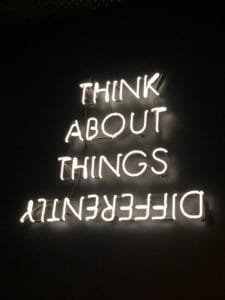
Getting Inclusion in the Workplace to Move off the Starting Block
Diversity and Inclusion simplified
The Rubik’s Cube was a challenge to solve, even for the creator of the cube himself. Ernő Rubik likely did not know back in 1974, when he created the toy, that there would be 43 quintillion ways to scramble the cube and a host of different problem-solving possibilities. This practically infinite amount of ways to scramble the cube would only be discovered many years later, thanks to the ability of supercomputers. It is now believed that there are two main methods to solving any of these numerous Rubik’s Cube’s scrambles, both of these methods combined offer over 500 hundred potential problem-solving algorithms. (1)
Just like the Rubik’s Cube was a challenge for its creator and many subsequent ‘cubers’ to solve, so to is the challenge of creating cultures of inclusion and optimising diversity in the workplace. In addition to this, finding a timely and appropriate algorithm that will shift all the cube’s faces into perfect alignment one synchronous move after the next in order to reach the ultimate end goal, may feel similar to how many leaders and managers feel in the workplace concerning diversity and inclusion. It can feel intimidating and possibly overwhelming, not knowing quite where to start or what to correct. Similarly, fostering cultures of diversity and inclusion also don’t happen by chance-these cultures require much thought, planning and an algorithm of sorts.
How is Rubik’s Cube a good visual representation of diversity?
Firstly, let’s have a look at the endless possibilities that are involved in a Rubik’s Cube ‘human scramble’.
Any person will possess both visible and non-visible characteristics. Let’s say for example, that each trait represents a coloured face on the cube. Some cubes are a 3 x 3 tile configuration, whilst others are a 4 x 4. This combination of qualities or traits makes up a person- who they are, how they see and interact with the world and the workplace, and finally, what they offer the workplace cognitively, socially and emotionally.
These visible traits include age, race, gender, ability or disability. The list of non-visible diversity traits is far more extensive and includes education, experience, marital status, parental status, religious ideology, creed, gender identity, present socioeconomic status, past socio-economic upbringing, culture, sexual orientation, neuro divergence, IQ, veteran status. This list is non-exhaustive, yet many traits are inviable at first glance and cannot be fully utilised without the right environment.
Subsequently, a multi-colour complex Rubik’s cube becomes a very accurate visual representation of human diversity. If each of these diverse characteristics were representative of one coloured tile, and a person possesses multiple coloured tiles, the infinite possibilities and combinations of a scrambled Rubik’s cube offer some understanding and perspective of the depth and deep levels of human diversity. Diversity is complex, multi-coloured, unique and often a challenge.
I wonder if you assigned each of your diversity traits a unique colour, what would your cube would look like?

The status quo in the workplace
Within the broader workplace or within a team, many scenarios can trigger climates of exclusion. For example, one HR policy can set off a sequence of events that results in feelings of exclusion and unfairness. Also, a recruitment decision results in perceptions of bias, or when poor cultural definitions are applied people can feel invisible. Additionally, a new manager who ignores gender derogatory jokes causes dissension in a team. These amongst many other factors can have a negative effect in the workplace. Perhaps it is due to these kinds of complex issues, that inclusion is often excluded from the diversity and inclusion partnership of business performance imperatives?
Inclusion needs an algorithm
Inclusion can indeed be uncomfortable and filled with uncertainty. It is less well-defined than diversity and often riddled with blind spots, individual perspectives, and is highly emotionally charged. Whereas, diversity, on the other hand, is numerically measurable and reportable. It, therefore, offers a more simple solution. Although, concerning visible diversity, what you see can be accounted for and reported on; however, it’s the deeper level diversity factors that also cement cultures of inclusion when they are bought to the table. How one person engages with, interacts and respects (or merely tolerates) another person’s views and opinions (or a group of people), will certainly have a reaction or an outcome.
Consequently, the first mistake of inclusion strategies is treating people purely based on their visible traits, and forgetting about the host of invisible ones. This tends to form an undercurrent of dissension and division in the workplace. Inclusion is centred around feelings of belonging, and most people develop a sense of belonging when they are actively contributing to their team or workplace. Generally, it is when the physical and non-physical traits of diversity an individual possesses are recognised and embraced, that true belonging and inclusion begin.

A Culture of Inclusion Tick List
Creating a culture of belonging and inclusion is certainly achievable. Here are a few signs that you have a diverse and inclusive workplace (or at least are heading in the right direction or know what is missing):
1. A culture of curiosity
One trait that is commonly observed in children is curiosity. Their brain is filling the gaps and widening their knowledge base with more information and new experiences. Adults who do the same do not fear ridicule or a hostile response when seeking out information or offering their feelings and sharing experiences with others.
2. Knowledge creation
The creation of knowledge requires people to feel comfortable with being vulnerable to raise a hand, and admit when they do not know the answer, share what they know and have the peace of mind (psychological safety) that there won’t be judged when they share or ask for information. Information (sharing about themselves, competitor knowledge, problem areas, etc.) promotes bonds created between people and fosters inclusive environments.
3. Innovation
Innovation closely follows knowledge creation. Environments and teams that foster and promote the open dialogue of numerous viewpoints and comfortably engage in heated discussions, debates and rounds of problem-solving (under the arch of psychological safety and leadership guidance), promote accelerated innovation and problem-solving.
4. Co-operation through healthy divergences
Inclusive environments evolve around co-operation with diverse opinions and viewpoints, they do not require the submission and yielding of any individual or group towards a set of ideologies or opinions of another. Inclusive workplaces harness the strength of numerous styles of education, experiences, opinions and beliefs in order to create a culture of respect and inclusion for all employees.
5. Collaboration
Workplaces that thrive on their existing diversity and inclusion have employees that are fully engaged. This happens by re-addressing the baseline core values of the team or workplace. By including the employees or the team in nominating their specific set of values, which becomes the pulse of the organisation, creating buy-in and gaining a ‘heart investment’ from people is a genuinely inclusive leadership decision.
6. Motivated people
Genuinely inclusive workplaces are invigorating. Why? Because when leaders and managers look beyond just the visible metrics of diversity and create a meaningful-day to-day culture for every person in the workplace, people can showcase their abilities. This in turn increases employee buy-in and motivation as promises of diversity and inclusion are no longer words or policies, but rather actions and behaviours that make everyone feel as though they are appreciated, liberated and accepted. The sky becomes the limit for a person who has the desire to contribute and perform.
I have heard diversity without inclusion referred to as dancing without music or eating nachos without salsa. Some things are meant to happen in tandem for a reason. Having an inclusion strategy, plan or algorithm for the workplace is a good plan for sustainability outcomes too. Assess what your team or workforce already possess (use my tick list as a guide) and then take active steps to alter the status quo by including visible and non-visible diversity as the starting point.

Kylie de Klerk
Gender Diversity and Inclusion – Sustainability & Culture
Kylie has worked for over a decade in and alongside corporate, high-pressure and diverse environments. She is a certified Employee Engagement Coach, holds a Science Degree and is presently a Higher Degree Researcher, actively publishing academic papers and researching topics related to gender diversity, sustainability and corporate governance. She also holds numerous certificates related to ethical governance, leadership, organisational behaviour, innovation and emotional intelligence.
If you are interested in learning more about Kylie and her workshops on Essemy, please visit this link.